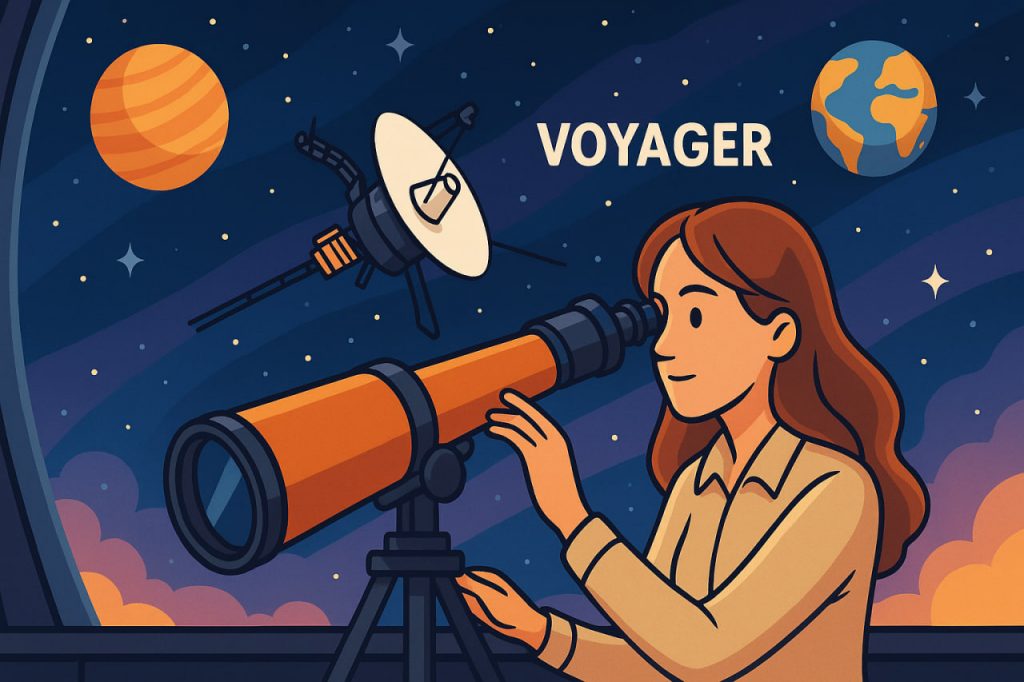In the late 1970s, two small spacecraft left Earth on a journey that would redefine exploration and stretch the boundaries of human imagination. Known as Voyager 1 and Voyager 2, these twin probes were launched by NASA to study the outer planets of our solar system — but their mission soon evolved into something far greater. Today, both Voyagers continue to travel through the cold expanse of interstellar space, carrying with them a golden record — a time capsule of human civilization — destined to wander the galaxy for billions of years. The Voyager Mission is not only a triumph of science and engineering but also a symbol of humanity’s desire to understand the cosmos and to be remembered among the stars.
The Launch and Original Goals
Voyager 2 launched first on August 20, 1977, followed by Voyager 1 on September 5 of the same year. Their mission was designed to take advantage of a rare planetary alignment that occurs only once every 176 years. This alignment allowed both spacecraft to use a “gravity assist” technique, where each planet’s gravity would sling them onward to the next, saving fuel and extending their journey. Voyager 2’s path took it past Jupiter, Saturn, Uranus, and Neptune — making it the only spacecraft to visit all four outer planets — while Voyager 1 focused on Jupiter and Saturn before heading toward the edge of the solar system.
Discoveries Among the Outer Planets
The Voyagers revolutionized our understanding of the solar system. At Jupiter, they revealed complex atmospheric storms, including detailed images of the Great Red Spot, and discovered volcanic activity on Io, one of Jupiter’s moons — the first evidence of active volcanism beyond Earth. At Saturn, the probes studied the intricate structure of its rings and captured the mysterious haze surrounding Titan, its largest moon. Voyager 2 later unveiled the deep blue color of Uranus and the supersonic winds of Neptune, along with the icy geysers of its moon Triton. Each discovery transformed textbooks and deepened our understanding of the diversity and complexity of planetary systems.
The Golden Record – Earth’s Message to the Cosmos
Perhaps the most poetic aspect of the Voyager mission is the Golden Record, a 12-inch gold-plated copper disc attached to each spacecraft. Curated by a team led by Carl Sagan, it contains sounds and images representing life and culture on Earth — from greetings in 55 languages and music from Bach to Chuck Berry, to natural sounds like thunder, birdsong, and ocean waves. It also includes diagrams explaining human biology, planetary maps, and the location of our solar system. The record serves as a message — or invitation — to any intelligent life that might someday find the spacecraft. As Sagan famously said, “The spacecraft will be encountered and the record played only if there are advanced spacefaring civilizations in interstellar space. But the launching of this bottle into the cosmic ocean says something very hopeful about life on this planet.”
Entering Interstellar Space
After decades of travel, both Voyagers reached a milestone no human-made object had ever achieved. Voyager 1 entered interstellar space in August 2012, followed by Voyager 2 in November 2018. This means they have passed beyond the heliosphere — the bubble-like region of space dominated by the solar wind — and are now traveling through the vast interstellar medium that exists between the stars. Their instruments continue to send back valuable data about cosmic radiation, magnetic fields, and the transition zone between solar and interstellar space, offering humanity its first direct measurements of this mysterious region.
The Legacy of Voyager
The Voyager mission continues to inspire scientists, engineers, and dreamers worldwide. Even after more than 45 years, both spacecraft still communicate with Earth via the Deep Space Network, though their power supplies are gradually fading. NASA expects contact to continue into the 2030s, after which the Voyagers will drift silently among the stars — their golden records enduring as the only artifacts of human civilization likely to outlast Earth itself. Their journey symbolizes humanity’s curiosity and our unquenchable drive to explore the unknown.
Expert Perspectives
According to astrophysicist Neil deGrasse Tyson, “The Voyager mission is the most romantic gesture humanity has ever made — a love letter to the universe.” Planetary scientist Linda Spilker, who has worked on Voyager since the 1970s, describes it as “the mission that keeps on giving,” noting that even now, the data they return reshapes our understanding of interstellar space. Meanwhile, physicist Brian Cox emphasizes the philosophical weight of the mission: “Voyager reminds us that we are a tiny part of something vast, yet capable of infinite imagination.”
The Future Beyond the Stars
As the Voyagers continue their endless journey, they carry not just instruments and data but the story of an entire species. In a few billion years, when the Sun has long faded, these spacecraft will still drift through the Milky Way, silent witnesses to the dawn of human exploration. The Voyager mission reminds us that exploration is not merely about discovery — it is about connection, endurance, and the eternal search for meaning in the infinite.
Interesting Facts
- Voyager 1 is the most distant human-made object, currently over 24 billion kilometers (15 billion miles) from Earth.
- The probes’ power comes from radioisotope thermoelectric generators (RTGs) that convert heat from decaying plutonium into electricity.
- Signals from the Voyagers take more than 22 hours to reach Earth, even at the speed of light.
- The Golden Record includes greetings from 55 languages, 116 images, and 90 minutes of music.
- Both spacecraft will continue traveling for billions of years, likely outlasting the Earth itself.
Glossary
- Heliosphere – The bubble-like region of space dominated by the Sun’s solar wind and magnetic field.
- Interstellar Space – The vast region between stars, filled with sparse gas, dust, and cosmic radiation.
- Gravity Assist – A maneuver that uses a planet’s gravity to accelerate and redirect a spacecraft.
- Radioisotope Thermoelectric Generator (RTG) – A device that generates power from the heat of radioactive decay.
- Cosmic Radiation – High-energy particles from outer space that can affect spacecraft and living organisms.
- Deep Space Network – NASA’s global system of radio antennas used to communicate with distant spacecraft.
- Carl Sagan – Renowned astronomer, author, and science communicator who helped design the Voyager Golden Record.
- Plasma – Ionized gas that makes up much of the interstellar medium.
- Magnetosphere – The region around a planet dominated by its magnetic field.
- Planetary Alignment – A rare configuration where planets line up in such a way that spacecraft can visit them efficiently.


